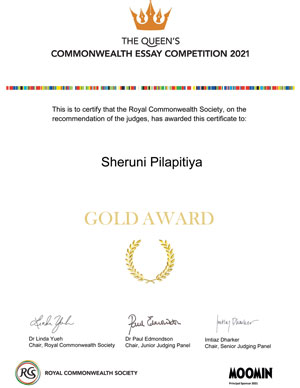OSC Student Sheruni Pilapitiya Wins Gold Award at ‘Queen’s Commonwealth Essay Competition’
View(s):
Sheruni Pilapitiya
Sheruni Pilapitiya – a student of The Overseas School of Colombo, was recently felicitated with the Gold Award for the ‘Queen’s Commonwealth Essay Competition’, bringing honour and pride to her alma mater and our very own island nation.
The Queen’s Commonwealth Essay Competition is the world’s oldest international writing competition for schools, established in 1883, with thousands of young people around the Commonwealth taking part each year.
Through her commendable and thought-provoking essay on ‘The Paradox of Connectivity in the COVID-19 Pandemic’, Sheruni passionately articulates the highly selective and disproportional nature of this new era of connectivity that the world has been launched into since the outbreak of the coronavirus pandemic. Her thoughts and sentiments on the virtual world being a facility for the privileged to create a sense of normalcy while failing to account for those unable to cope with the virtual takeover, urges one to truly pause and reflect on the current reality that remains obscure to many.
Sheruni’s earnest appeal to truly stay connected to the world beyond our individual experiences strikes a powerful chord in the hearts of the reader, as she eloquently captures the paradox that defines our current reality. Below is the award-winning feature – a must-read for all!
THE PARADOX OF CONNECTIVITY IN THE COVID-19 PANDEMIC
In an era of disconnect, it is a cruel irony that our ‘connectivity’ depends on our socio-economic status. Indeed, the prerogative to stay connected amidst a raging pandemic seems to simply enhance the divide between the privileged and the underprivileged, thereby accentuating the disparity that exists between social classes.
A notable portion of my teenage years has been reduced to a 4x4cm square on an exhausting screen, long facetime calls, and never-ending zoom webinars. However, I have been fortunate to have a steady education with all of the resources in a normal school environment still being available.
Despite the physical distance, I am able to communicate with family and friends across time zones and borders, and maintain the social skills which added meaning to my daily routines. In the comfort of a home which can be supported in isolation, I have continued my schooling and exams, expanding my knowledge and even embarking on new activities with the abundance of time available at home.
I have the space to explore myself and prepare for the next chapters of my life, whilst taking care of my physical and mental health.
Through social media forums I am able to see my friends enjoy their lives, and stay updated on the news. It is a luxury to be able to comfortably isolate myself, whilst maintaining connectivity with the real world and continuing the pursuits which I hope to embark on.
Not far from the city, my home in Sri Lanka sits adjacent to the picturesque Thalangama Lake. We often navigate through casually grazing cows, or speeding motorbikes, while the sound of honking horns echoes off the cars passing by dangerously close.
Streaks of pink will often paint blue skies, and the streets hug the curve of the vast lake covered in a carpet of lily pads. Towering trees frame the path, dancing in the wind, choreographed like Kandyan dancers.
This road, now neglected by local authorities, has come to represent a pandemic that has crippled the market for low-wage earners to complete the critical function of city maintenance. The street, once lined with vibrant food stalls and local businesses, is now desolate. Empty roadside stalls now pepper my vista — they reflect the local businesses and daily wage earners left behind in the new era of global connectivity.
The small businesses which depended on those passing through the town are out of service. My observations of the countless empty stalls and closed down huts are a mere snippet of the disruption to livelihoods.
As such, for most of the population, the threat of the pandemic runs secondary to the threat of more imminent threats, such as bankruptcy, starvation, or lack of shelter. Connectivity is an afterthought when placed next to basic survival needs. Within the communities we live in, even if we live in comfort with heightened global connectivity, our experience is so drastically disconnected from those with different opportunities and livelihoods. Connected by the same pothole filled road, my experiences run perpendicular to many around me. Perhaps the intersecting point is our initial exposure to the virus, after which opportunities and socio-economic status in society continually determine our individual experiences.
In the world of the global age, borders are demarcated along the lines of socio economic classes. A minority of the global population have an abundance of resources, whilst the majority face scarcity everyday.
The ramifications of the COVID-19 pandemic are no exception. Higher income countries, such as the USA and Canada have the highest rates of vaccine distribution with over 60% of citizens having received at least their first dosage. Conversely, countries such as India have vaccination rates of under 20%, and
the global average percentage is a mere 23% (OWID).
Like most major global disasters, whether it be wars or famines, the COVID-19 pandemic is gradually seeing higher income communities optimize resources, whilst lower income communities battle with the stagnating impact of the virus and a lack of healthcare facilities.
The pandemic has undoubtedly had global ramifications, but communities with better facilities are becoming more equipped to battle it until the virus
will disproportionately affect lower income countries.
The virtual world which we are seemingly adapting to is being labelled as the new normal. Yet this
virtual world is a facility for privileged communities to create a sense of normality, whilst failing to account for the disruption of smaller local businesses and communities which cannot function amidst this virtual takeover.
We assume that the countries which are dominating the media and displaying a return to normality are representative of the entire world.
The sad reality is that whilst a handful of countries are able to return to ‘no lockdowns’, annual festivals and mask-free cities, a majority of communities face further turmoil as the virus mutates. Thus, as we grapple with the concept of staying connected through the COVID-19 pandemic, we must also question the selective nature of this connectivity.
A harmful narrative regarding our connectedness through the pandemic is that our current ‘internet generation’ is well equipped for a global crisis due to the existing virtual dependency. Compared to previous generations, we currently have immense advancements in technology which have enabled communities to continue functioning despite physical distance.
However this narrative privileges those with certain resources whilst undermining the struggles of underprivileged communities which cannot be supported in a virtual world. There is a large population of children who have been deprived of an education in the two year span of this pandemic.
Over 1 billion children are at risk of falling behind in education, and while remote learning programs have been implemented, many of the world’s children do not have access to internet access, personal computers, TVs or even radio at home (Unicef).
With 75% of the children who cannot access remote learning being from poorer households (Unicef), existing learning inequalities are only being amplified. Considering the situation, it is vital that communities do not rely on one sole remote learning channel to connect all children, and focus on expanding digital resource access to reduce learning vulnerabilities.
Has our virtual global connectivity run at the cost of increasing the disconnect between privileged and underprivileged communities?
And has this pandemic truly connected us more to the world, or only to those who share our experiences and opportunities, furthering existing disparities? As higher income communities return to normal life and lower income communities grapple with lack of media
representation and a scarcity of healthcare facilities and resources, it is essential that we stay connected to the world beyond our individual experiences.
Vesak Poya is the festival of lights — a chance for rejuvenation, reflection, and hope for the future. It commemorates the birth, death and resurrection of Gautama Buddha.
This year, during Vesak Poya, the coronavirus extinguished the coloured lanterns which would normally adorn bustling roads.
Normally, the annual festival would see food carts, statues, and a year’s worth of elaborate lanterns illuminating a deep blue sky. Each lantern held a story, love, effort and time.
Some were double my height, towering over bright eyed children snacking on manioc chips, some had intricate story frames, holding snippets of Buddhist philosophy, and some would rotate as their colours changed, leaving bypassers in awe.
The spirit of Vesak would flood out of small homes decorated beautifully onto the brightly lit main roads. Whether you were driving by or walking through the town, the festive lights were everywhere.
This year, however, the streets were quiet.
For the majority, due to the pandemic, celebrations were halted and the streets remained dim. But on this auspicious day, my family and I were able to light oil lanterns around our home, and decorate the trees with coloured lamps and carefully crafted lights. Within our isolation, our world remained illuminated. The ability to celebrate such a festival despite the standstill that the world has come to is a privilege.
I am confronted with bittersweet emotions; our home could not light up the entire town.
Likewise, whilst pockets of us amidst this pandemic are able to stay connected to pre-pandemic traditions, and connect with our families and roots, this is not a privilege afforded to everyone.
This is the paradox that defines our current reality.


